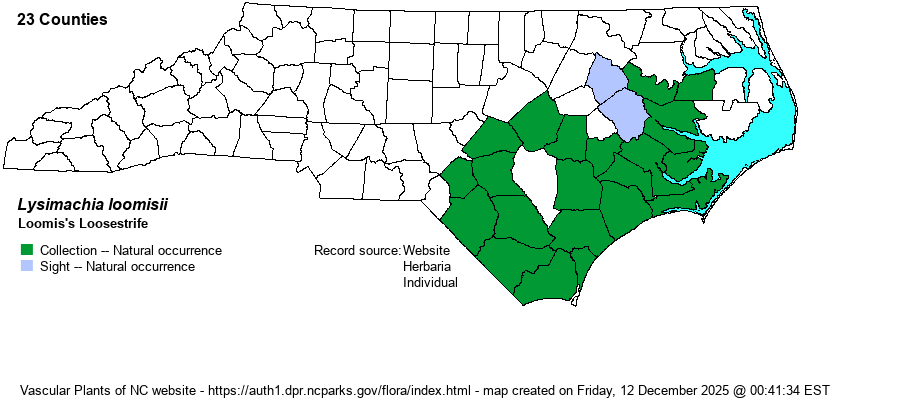| Author | Torrey | |
| Distribution | Present over most of the southern 2/3 of the Coastal Plain, north and east to Edgecombe, Martin, Washington, and Carteret counties. It does not quite range west into the Sandhills region.
This is essentially a Carolina endemic, ranging from eastern NC south to southeastern SC, disjunct to eastern GA.
| |
| Abundance | Uncommon to infrequent in most of the range, though can be locally fairly common in a few places (well-managed natural areas). The NCNHP considers this as a Watch List species. | |
| Habitat | This species grows mostly in wet pine savannas and borders of pocosins, but it can also occur in wet powerline clearings, other sunny and damp ground, and less so in ditches and marshes. |
| Phenology | Blooms in May and June, and fruits from August to October. | |
| Identification | This and L. asperulifolia are the two savanna/pocosin species in the genus, and have somewhat similar ranges, though this species occurs farther north but not west into the Sandhills. It has a slender stem, growing to about 1.5 feet tall; it often has some branches from the upper part of the stem. Unlike others in the genus, it is extremely leafy, with an abundance of paired or whorled stem and branch leaves, plus smaller ones in some axils; each leaf is very slender and linear in shape. The leaves are sessile, entire but with revolute (rolled under) margins, reaching about 1.5 inches long but barely 1/5-inch wide at best. As with L. asperulifolia, it has a terminal and basically naked raceme, several inches tall, with a handful of yellow flowers in bloom at a time. Each flower is about 2/3-inch across. This is a quite conspicuous plant in bloom, with its many yellow flowers, and like most others in the genus, usually grows in dense patches or colonies. It is the only Lysimachia where there are too many leaves to count, and that leafiness, with needle-like leaves, should make it easy to identify even without an inflorescence. As with all savanna herbaceous plants, it strongly requires prescribed burns or other similar disturbances for its survival, as these small plants can be easily shaded out by woody vegetation. | |
| Taxonomic Comments | None
Weakley (2020) has split out Steironema from Lysimachia based on a 2018 paper using molecular research; and in so doing has gone back to "old" taxonomy. In Lysimachia there are no staminodes and the leaves are punctate with elongate markings (vs. staminodes present and punctae absent in Steironema). | |
| Other Common Name(s) | Carolina Loosestrife, Loomis's Yellow Loosestrife | |
| State Rank | S3 | |
| Global Rank | G3? | |
| State Status | W1 | |
| US Status | | |
| USACE-agcp | OBL link |
| USACE-emp | OBL link |

